Day 4 (Tuesday, 21-7-98)
The sky was overcast and gray, we got up by 6h00 and got going at 7h10. This must be some sort of record. Not far from our camp was one of these small ice bergs, which looked like it was ready to collapse, being deeply undercut by wave action. And alas as we walked past it on our way out we heard this noise and there it was, the top falling into the water. One has to wonder what the probability of this happening the moment we were walking past. It was possibly the noise from our boots that broke the camels back.
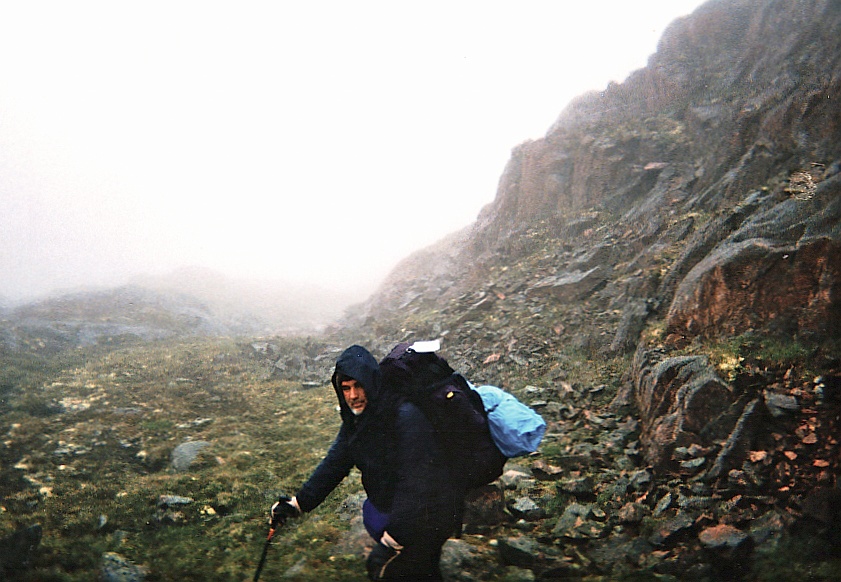 Initially we followed the road further north and just before the next sheep farm went off into the hills. A climb of 700m lay in front of us and that with 22kg of a rucksack on our back. I was certainly getting very exhausted and needed Jim's encouragement to get up to the top and over. What I also noticed was my lack of apatite. I usually have this in the Drakensberge and ascribe it to the altitude. But here we are at low level and still I wasn't hungry.
Initially we followed the road further north and just before the next sheep farm went off into the hills. A climb of 700m lay in front of us and that with 22kg of a rucksack on our back. I was certainly getting very exhausted and needed Jim's encouragement to get up to the top and over. What I also noticed was my lack of apatite. I usually have this in the Drakensberge and ascribe it to the altitude. But here we are at low level and still I wasn't hungry.
At the higher altitude we had to cope with low temperatures (4°C), mist and rain. It made orientation difficult and led us off the path. Low shrubs and loose rocks hindered our decent and when finally we got down we had enough and started searching for a campsite. Rain had set in properly and once the tent was up we moved in and everything happened on the inside. This was the first time we had to do this, later on we became experts at it. Each one of us would take over one end of the tent and cook in the bell. The inside of my tent is large, it was sold as a 3-man tent, giving us plenty of room to kick things around and make ourselves comfortable.
Day 5 (Wednesday, 22-7-98)
Early in the morning we were awoken by the screeching of a bird very close to the tent, before it was possible to establish what it was it flew off. By the slow and heavy flapping of the wings we could at least establish that it was a big one, but what? One can only speculate. It was still drizzling and breakfast was eaten in bed. I started eating my Gorgonzola cheese, which I had bought in Switzerland, it was nice on pumpernickel, desert was pumpernickel with strawberry jam. There was no delaying, we packed as much as we could from the inside and then on with the rain gear and down with the tent. We were in a hurry, coming down the mountain the previous afternoon we had our first glimpse of the glacier, Qajuuttap Sermia its called. To get to the camping spot at the bay Qajuuttaq was about 5km of clear run, all slightly downhill and on a path most of the time. We were not alone there was one group of French hikers (3) and an other group that we didn't get to talk to. The French had done what I had planned initially and that was going over John Dahl Land and then to come over the Kukuloog river to this side. I was warned that the river is strong flowing and very cold and we shouldn't attempt it. The French confirmed this by telling us that they walked along the river for a long while trying to find a place to cross, in desperation they eventually went across. The crossing was very dangerous, water flowing strongly and being ice-cold, they would have had major problems if one of them had lost his footing. Since they were busy packing we decide to take over the campsite, it had a fire place and still some wood.
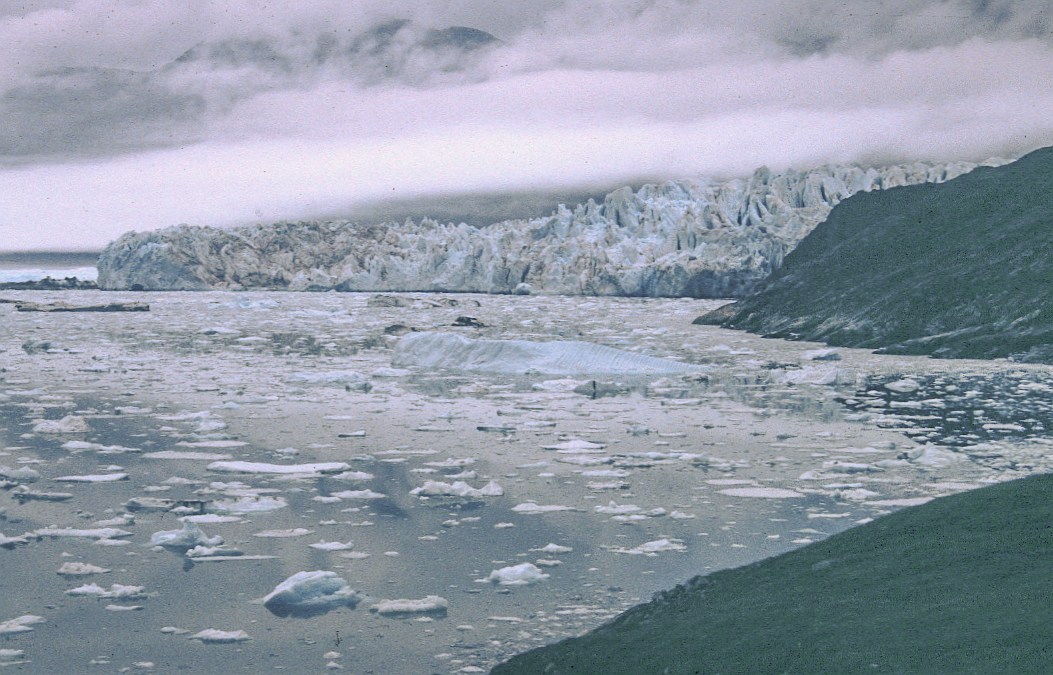 After a cup of coffee the tent was set up and all our possessions moved in. It was about midday. The glacier had to be explored. Walking along the shore line towards the glacier initially was easy, but later on the cliffs started coming down to the water's edge forcing us up the mountain and through some not so pleasant undergrowth and loose rocks. After a 2½ km walk we were there, close to the point where the glacier falls into the fjord. Clambering down to it we could touch it and also climb onto it for a bit. And we could also hear it moan and groan as it moves towards the sea, but movement was not visible. The affect of the moving ice on the sides of the mountain was clearly visible, soil and rocks being pushed along and out of the way, this was geology in action. So much better than listening to a teacher in school telling us about glaciers and things like this.
After a cup of coffee the tent was set up and all our possessions moved in. It was about midday. The glacier had to be explored. Walking along the shore line towards the glacier initially was easy, but later on the cliffs started coming down to the water's edge forcing us up the mountain and through some not so pleasant undergrowth and loose rocks. After a 2½ km walk we were there, close to the point where the glacier falls into the fjord. Clambering down to it we could touch it and also climb onto it for a bit. And we could also hear it moan and groan as it moves towards the sea, but movement was not visible. The affect of the moving ice on the sides of the mountain was clearly visible, soil and rocks being pushed along and out of the way, this was geology in action. So much better than listening to a teacher in school telling us about glaciers and things like this.
From the low shrub, which I think are arctic birch trees, there was plenty of dry wood around, enough to make a fire. It was mainly utilised to partially dry our boots and socks and also to give us some warmth, the wind blowing over the ice was fairly cold. I can't give any temperatures, because at this stage my thermometer had already been smashed.
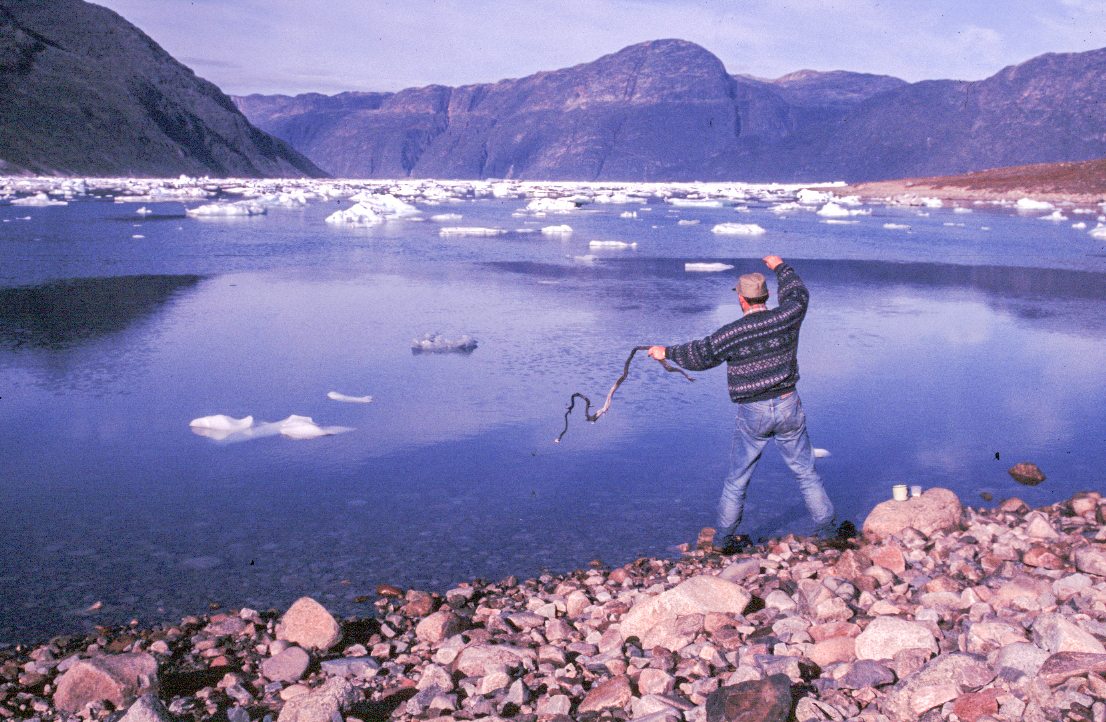 Coming back to the tent, Jim went fishing and I collected more fire wood. The sun had penetrated the clouds and it was very pleasant now. Jim had brought a line and a hook, a dry stick was used as a fishing rod and bait, I don't know what he used, but it didn't work. We could see the fish, but they weren't interested in the hook. The fire was started and a cloth line set up next to it for drying of our wet things, which we had plenty of.
Coming back to the tent, Jim went fishing and I collected more fire wood. The sun had penetrated the clouds and it was very pleasant now. Jim had brought a line and a hook, a dry stick was used as a fishing rod and bait, I don't know what he used, but it didn't work. We could see the fish, but they weren't interested in the hook. The fire was started and a cloth line set up next to it for drying of our wet things, which we had plenty of.
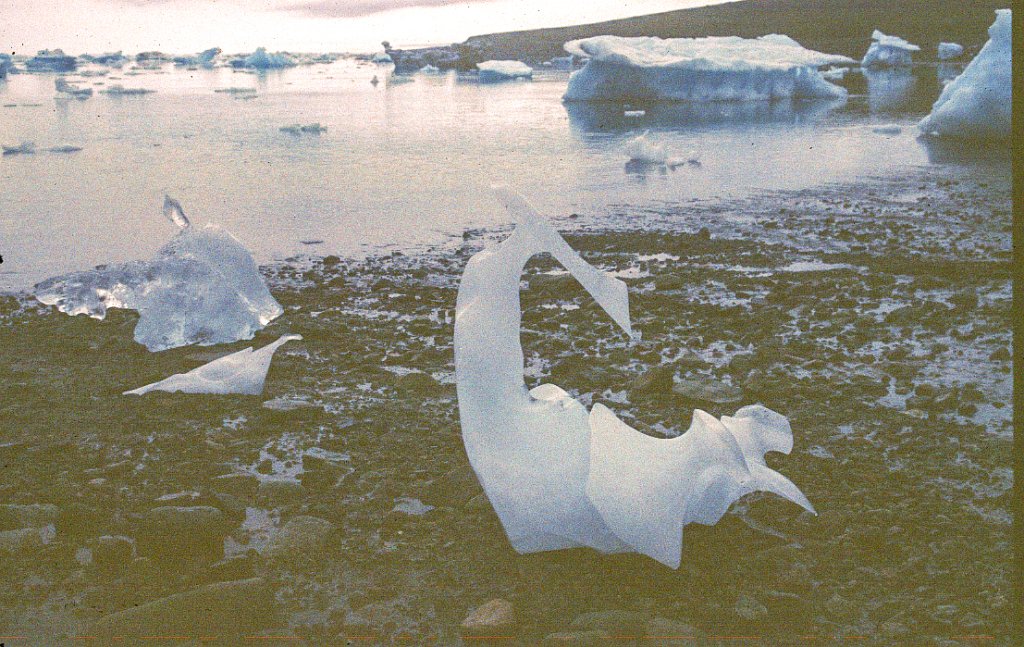 The scenery was beautiful, the bay had plenty of pieces of ice floating around, big ones, small ones, the whole range and some of them had been dumped on the beach by the tide and left behind to be collected again by the next tide. The stranded ice was a photographers paradise, or it would have been, but my camera was giving me problems. The exposure meter had given in again and I had to judge the exposure myself. This put a bit of damper on my photographic activity, I was pissed off. That is the third time the camera has done this and it didn't help at this stage hat the previous repair was still under guarantee. Fortunately the digital age came to the rescue and I could recover some quality.
The scenery was beautiful, the bay had plenty of pieces of ice floating around, big ones, small ones, the whole range and some of them had been dumped on the beach by the tide and left behind to be collected again by the next tide. The stranded ice was a photographers paradise, or it would have been, but my camera was giving me problems. The exposure meter had given in again and I had to judge the exposure myself. This put a bit of damper on my photographic activity, I was pissed off. That is the third time the camera has done this and it didn't help at this stage hat the previous repair was still under guarantee. Fortunately the digital age came to the rescue and I could recover some quality.
Day 6 (Thursday, 23-7-98)
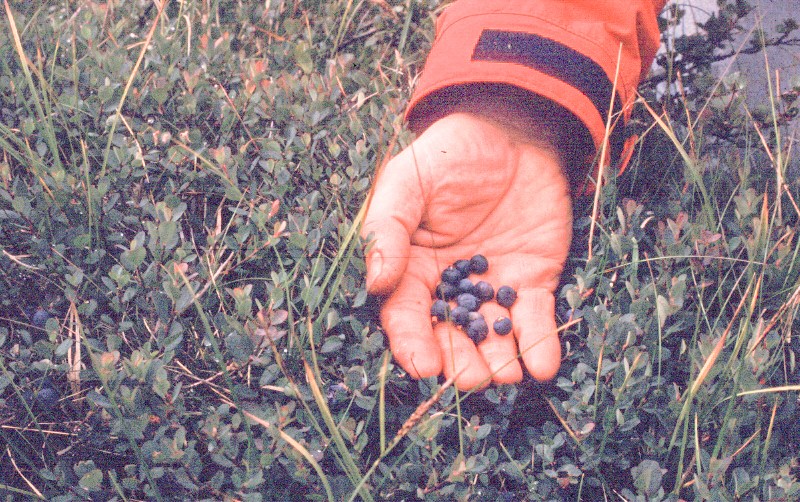 Jim announced that it was 7h00 and that the sun was shining. This was good news and we were up, using the sun to dry some of our possessions. After breakfast we took a stroll up the valley behind hill 510 to get a view of the glacier higher up. Hill 510 is so called because of its height, 510 meter.
A fair crop of blueberries (Vaccinium uliginosum) made the hike up to the saddle very pleasant. From there we had a good but incomplete view over the glacier. To get the full view we had to get to the top of the hill by slicing around its back. The wind by now was blowing strong and depending on the direction it would either blow me up the mountain or push me down. I was worried about the tent which we had left behind with all our belongings inside.
Lunch was declared behind a sheltering rock near the top. We should have studied the map before going down, because there is one easy way and an infinite number of not so nice routes, all over sticks and stones and loose rocks and undergrowth.
Jim announced that it was 7h00 and that the sun was shining. This was good news and we were up, using the sun to dry some of our possessions. After breakfast we took a stroll up the valley behind hill 510 to get a view of the glacier higher up. Hill 510 is so called because of its height, 510 meter.
A fair crop of blueberries (Vaccinium uliginosum) made the hike up to the saddle very pleasant. From there we had a good but incomplete view over the glacier. To get the full view we had to get to the top of the hill by slicing around its back. The wind by now was blowing strong and depending on the direction it would either blow me up the mountain or push me down. I was worried about the tent which we had left behind with all our belongings inside.
Lunch was declared behind a sheltering rock near the top. We should have studied the map before going down, because there is one easy way and an infinite number of not so nice routes, all over sticks and stones and loose rocks and undergrowth.
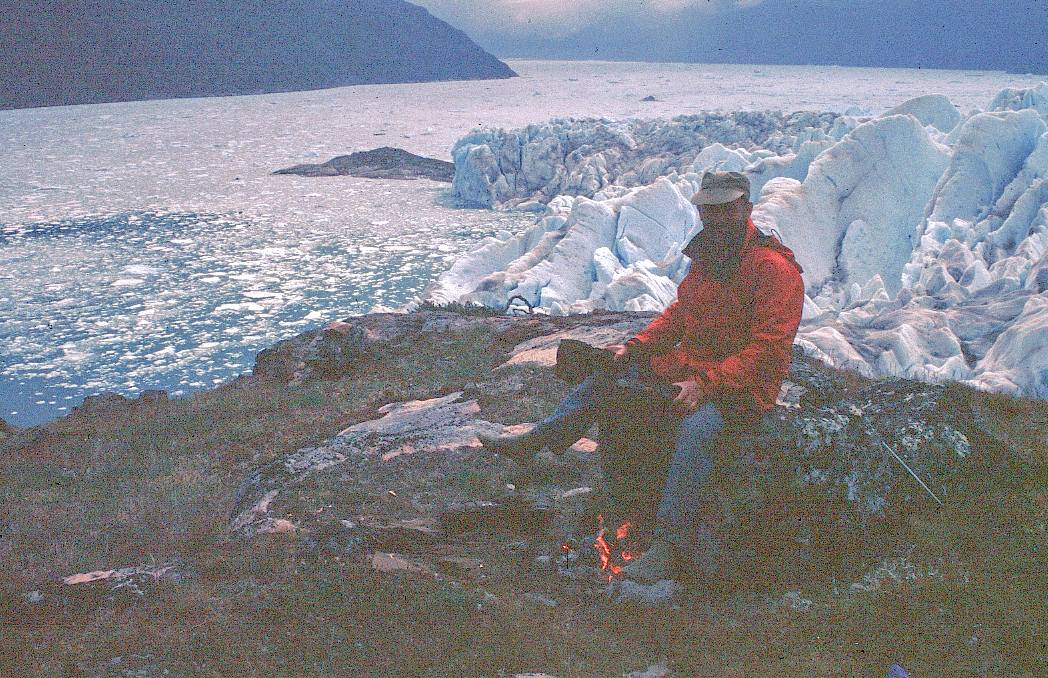 The first and only four legged wild life was seen here, a white arctic hare. Mushroom collection was the order of the day, we found a fair quantity of Gronlandak Birke-Rorhat or botanically Leccinum sp. (I don't know what the sp. stands for, I found this information in a book that was all in Danish), a close relative to the Birkenpilz (Leccinum scabrum) which is known to me from my German forests. The interesting aspect of these mushrooms is that they do not grow in groups, they are well spread out and one has to walk for some distance to find the next one. Fortunately they do not hide themselves, at least not the ones that we picked, and can be seen from a few meters away.
The first and only four legged wild life was seen here, a white arctic hare. Mushroom collection was the order of the day, we found a fair quantity of Gronlandak Birke-Rorhat or botanically Leccinum sp. (I don't know what the sp. stands for, I found this information in a book that was all in Danish), a close relative to the Birkenpilz (Leccinum scabrum) which is known to me from my German forests. The interesting aspect of these mushrooms is that they do not grow in groups, they are well spread out and one has to walk for some distance to find the next one. Fortunately they do not hide themselves, at least not the ones that we picked, and can be seen from a few meters away.
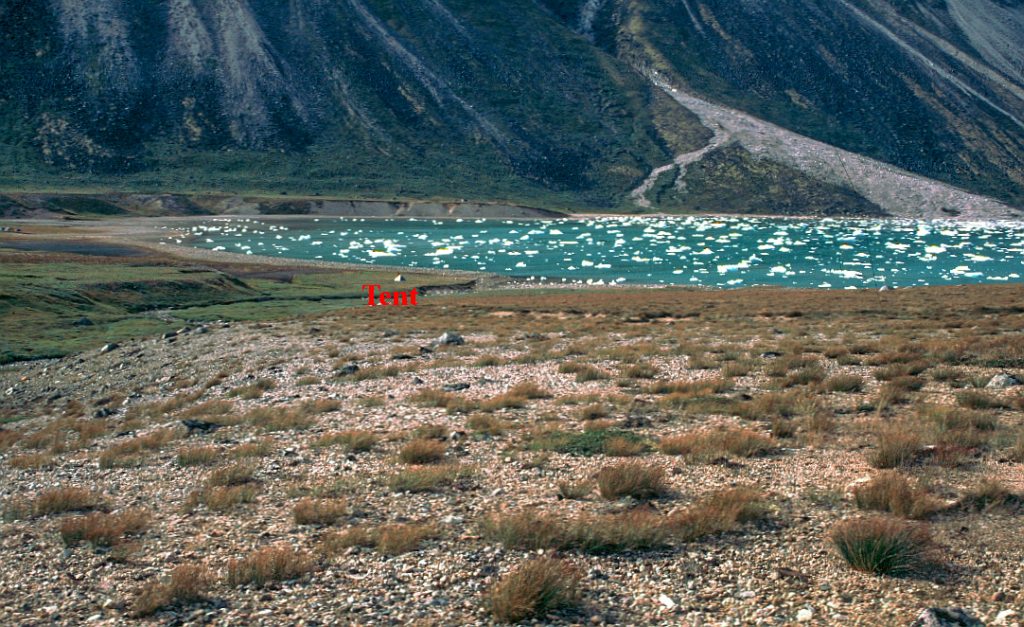 Arriving at the tent we found that the wind had pushed the tent out of shape, initially I was disappointed with my tent, but later through the trip realised that this is the way it copes with high wind and that it maintains its water resistance even under those condition. During the night the wind became even more severe and very gusty. It would be quiet for a while and then suddenly give it another push. The air felt somewhat warm and had the smell of a föhn wind as I know it from the Alps, so I will say we had a föhn.
Arriving at the tent we found that the wind had pushed the tent out of shape, initially I was disappointed with my tent, but later through the trip realised that this is the way it copes with high wind and that it maintains its water resistance even under those condition. During the night the wind became even more severe and very gusty. It would be quiet for a while and then suddenly give it another push. The air felt somewhat warm and had the smell of a föhn wind as I know it from the Alps, so I will say we had a föhn.
Another effect of the wind was that it had pushed all the ice away from the shore out of the bay towards the glacier. This was a bit of a disappointment since I had planned to take more pictures of the stranded pieces of ice on shore. The tide and the wind had taken them all.
For dinner we had fried mushrooms and smash and a handful of blueberries for desert.
Day 7 (Friday, 24-7-98)
 The scenery was tremendous, looking back we could see the mighty Kukuloog river winding its way from out the mountains into the flood plain, looking to the right there was the last view of the glacier sticking its nose into the fjord. And going forward there was a series of small and large lakes and we missed the path. It took us a bit of walking sideways over two ridges, not more than 50m up, to get to the valley we wanted to be in. The aim was to stay in the mountains for the night and to enjoy one of these lakes. A double lake marked on the map as 'Iviangiusannguit' was selected, altitude 530m. Our tent was put up between the two lakes and was aptly named Interlaken. Drizzle set in and living was done in the tent.
The scenery was tremendous, looking back we could see the mighty Kukuloog river winding its way from out the mountains into the flood plain, looking to the right there was the last view of the glacier sticking its nose into the fjord. And going forward there was a series of small and large lakes and we missed the path. It took us a bit of walking sideways over two ridges, not more than 50m up, to get to the valley we wanted to be in. The aim was to stay in the mountains for the night and to enjoy one of these lakes. A double lake marked on the map as 'Iviangiusannguit' was selected, altitude 530m. Our tent was put up between the two lakes and was aptly named Interlaken. Drizzle set in and living was done in the tent.
The lakes are really inviting, but the temperature is not. I went for a wash and wading into the water nearly froze off my feet. Its such a pity, these lakes are so inviting with their crystal clear water.
next page
return to home page
 Initially we followed the road further north and just before the next sheep farm went off into the hills. A climb of 700m lay in front of us and that with 22kg of a rucksack on our back. I was certainly getting very exhausted and needed Jim's encouragement to get up to the top and over. What I also noticed was my lack of apatite. I usually have this in the Drakensberge and ascribe it to the altitude. But here we are at low level and still I wasn't hungry.
Initially we followed the road further north and just before the next sheep farm went off into the hills. A climb of 700m lay in front of us and that with 22kg of a rucksack on our back. I was certainly getting very exhausted and needed Jim's encouragement to get up to the top and over. What I also noticed was my lack of apatite. I usually have this in the Drakensberge and ascribe it to the altitude. But here we are at low level and still I wasn't hungry. After a cup of coffee the tent was set up and all our possessions moved in. It was about midday. The glacier had to be explored. Walking along the shore line towards the glacier initially was easy, but later on the cliffs started coming down to the water's edge forcing us up the mountain and through some not so pleasant undergrowth and loose rocks. After a 2½ km walk we were there, close to the point where the glacier falls into the fjord. Clambering down to it we could touch it and also climb onto it for a bit. And we could also hear it moan and groan as it moves towards the sea, but movement was not visible. The affect of the moving ice on the sides of the mountain was clearly visible, soil and rocks being pushed along and out of the way, this was geology in action. So much better than listening to a teacher in school telling us about glaciers and things like this.
After a cup of coffee the tent was set up and all our possessions moved in. It was about midday. The glacier had to be explored. Walking along the shore line towards the glacier initially was easy, but later on the cliffs started coming down to the water's edge forcing us up the mountain and through some not so pleasant undergrowth and loose rocks. After a 2½ km walk we were there, close to the point where the glacier falls into the fjord. Clambering down to it we could touch it and also climb onto it for a bit. And we could also hear it moan and groan as it moves towards the sea, but movement was not visible. The affect of the moving ice on the sides of the mountain was clearly visible, soil and rocks being pushed along and out of the way, this was geology in action. So much better than listening to a teacher in school telling us about glaciers and things like this. Coming back to the tent, Jim went fishing and I collected more fire wood. The sun had penetrated the clouds and it was very pleasant now. Jim had brought a line and a hook, a dry stick was used as a fishing rod and bait, I don't know what he used, but it didn't work. We could see the fish, but they weren't interested in the hook. The fire was started and a cloth line set up next to it for drying of our wet things, which we had plenty of.
Coming back to the tent, Jim went fishing and I collected more fire wood. The sun had penetrated the clouds and it was very pleasant now. Jim had brought a line and a hook, a dry stick was used as a fishing rod and bait, I don't know what he used, but it didn't work. We could see the fish, but they weren't interested in the hook. The fire was started and a cloth line set up next to it for drying of our wet things, which we had plenty of. The scenery was beautiful, the bay had plenty of pieces of ice floating around, big ones, small ones, the whole range and some of them had been dumped on the beach by the tide and left behind to be collected again by the next tide. The stranded ice was a photographers paradise, or it would have been, but my camera was giving me problems. The exposure meter had given in again and I had to judge the exposure myself. This put a bit of damper on my photographic activity, I was pissed off. That is the third time the camera has done this and it didn't help at this stage hat the previous repair was still under guarantee. Fortunately the digital age came to the rescue and I could recover some quality.
The scenery was beautiful, the bay had plenty of pieces of ice floating around, big ones, small ones, the whole range and some of them had been dumped on the beach by the tide and left behind to be collected again by the next tide. The stranded ice was a photographers paradise, or it would have been, but my camera was giving me problems. The exposure meter had given in again and I had to judge the exposure myself. This put a bit of damper on my photographic activity, I was pissed off. That is the third time the camera has done this and it didn't help at this stage hat the previous repair was still under guarantee. Fortunately the digital age came to the rescue and I could recover some quality. Jim announced that it was 7h00 and that the sun was shining. This was good news and we were up, using the sun to dry some of our possessions. After breakfast we took a stroll up the valley behind hill 510 to get a view of the glacier higher up. Hill 510 is so called because of its height, 510 meter.
A fair crop of blueberries (Vaccinium uliginosum) made the hike up to the saddle very pleasant. From there we had a good but incomplete view over the glacier. To get the full view we had to get to the top of the hill by slicing around its back. The wind by now was blowing strong and depending on the direction it would either blow me up the mountain or push me down. I was worried about the tent which we had left behind with all our belongings inside.
Lunch was declared behind a sheltering rock near the top. We should have studied the map before going down, because there is one easy way and an infinite number of not so nice routes, all over sticks and stones and loose rocks and undergrowth.
Jim announced that it was 7h00 and that the sun was shining. This was good news and we were up, using the sun to dry some of our possessions. After breakfast we took a stroll up the valley behind hill 510 to get a view of the glacier higher up. Hill 510 is so called because of its height, 510 meter.
A fair crop of blueberries (Vaccinium uliginosum) made the hike up to the saddle very pleasant. From there we had a good but incomplete view over the glacier. To get the full view we had to get to the top of the hill by slicing around its back. The wind by now was blowing strong and depending on the direction it would either blow me up the mountain or push me down. I was worried about the tent which we had left behind with all our belongings inside.
Lunch was declared behind a sheltering rock near the top. We should have studied the map before going down, because there is one easy way and an infinite number of not so nice routes, all over sticks and stones and loose rocks and undergrowth. The first and only four legged wild life was seen here, a white arctic hare. Mushroom collection was the order of the day, we found a fair quantity of Gronlandak Birke-Rorhat or botanically Leccinum sp. (I don't know what the sp. stands for, I found this information in a book that was all in Danish), a close relative to the Birkenpilz (Leccinum scabrum) which is known to me from my German forests. The interesting aspect of these mushrooms is that they do not grow in groups, they are well spread out and one has to walk for some distance to find the next one. Fortunately they do not hide themselves, at least not the ones that we picked, and can be seen from a few meters away.
The first and only four legged wild life was seen here, a white arctic hare. Mushroom collection was the order of the day, we found a fair quantity of Gronlandak Birke-Rorhat or botanically Leccinum sp. (I don't know what the sp. stands for, I found this information in a book that was all in Danish), a close relative to the Birkenpilz (Leccinum scabrum) which is known to me from my German forests. The interesting aspect of these mushrooms is that they do not grow in groups, they are well spread out and one has to walk for some distance to find the next one. Fortunately they do not hide themselves, at least not the ones that we picked, and can be seen from a few meters away.
 Arriving at the tent we found that the wind had pushed the tent out of shape, initially I was disappointed with my tent, but later through the trip realised that this is the way it copes with high wind and that it maintains its water resistance even under those condition. During the night the wind became even more severe and very gusty. It would be quiet for a while and then suddenly give it another push. The air felt somewhat warm and had the smell of a föhn wind as I know it from the Alps, so I will say we had a föhn.
Arriving at the tent we found that the wind had pushed the tent out of shape, initially I was disappointed with my tent, but later through the trip realised that this is the way it copes with high wind and that it maintains its water resistance even under those condition. During the night the wind became even more severe and very gusty. It would be quiet for a while and then suddenly give it another push. The air felt somewhat warm and had the smell of a föhn wind as I know it from the Alps, so I will say we had a föhn. The scenery was tremendous, looking back we could see the mighty Kukuloog river winding its way from out the mountains into the flood plain, looking to the right there was the last view of the glacier sticking its nose into the fjord. And going forward there was a series of small and large lakes and we missed the path. It took us a bit of walking sideways over two ridges, not more than 50m up, to get to the valley we wanted to be in. The aim was to stay in the mountains for the night and to enjoy one of these lakes. A double lake marked on the map as 'Iviangiusannguit' was selected, altitude 530m. Our tent was put up between the two lakes and was aptly named Interlaken. Drizzle set in and living was done in the tent.
The scenery was tremendous, looking back we could see the mighty Kukuloog river winding its way from out the mountains into the flood plain, looking to the right there was the last view of the glacier sticking its nose into the fjord. And going forward there was a series of small and large lakes and we missed the path. It took us a bit of walking sideways over two ridges, not more than 50m up, to get to the valley we wanted to be in. The aim was to stay in the mountains for the night and to enjoy one of these lakes. A double lake marked on the map as 'Iviangiusannguit' was selected, altitude 530m. Our tent was put up between the two lakes and was aptly named Interlaken. Drizzle set in and living was done in the tent.